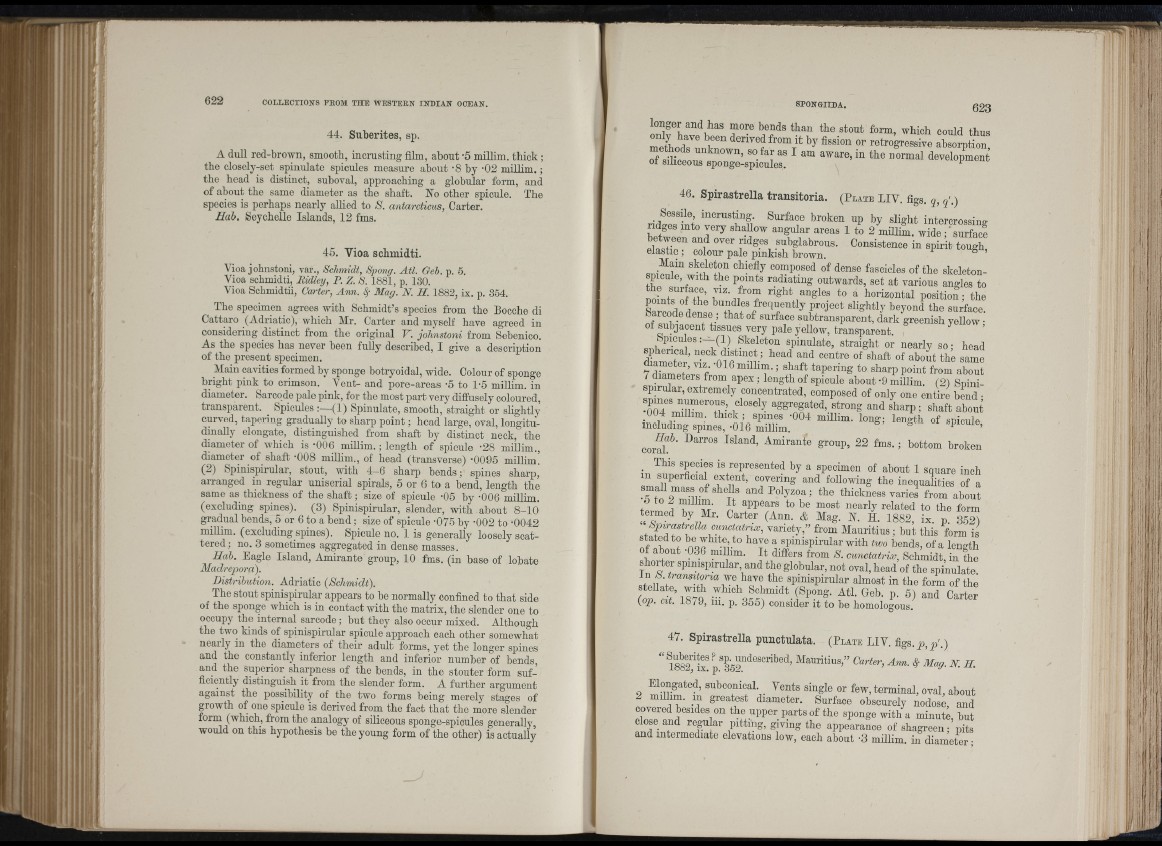
u IE
f t
fl*
li
II
«!
622 C O L L E C T I O N S E E O M T H E W E S T E E N I N D I A N O C E A N .
44. Suberites, sp.
A dull red-brown, smootb, incrusting iilni, about '5 miUim. tbick ;
tbe closely-set spinulate spicules measure about "8 by ’02 millim.;
tbe bead is distinct, suboval, approaching a globular form, and
of about tbe same diameter as the shaft. No otber spicule. The
species is perhaps nearly allied to S. antarcticus, Carter.
Hah. SeycbeUe Islands, 12 fms.
45. Vioa schmidti.
Vioa jobnstoni, var., Schmidt, Spong. Atl. Geb. p. 5.
Vioa schmidti, Ridley, P. Z. S. 1881, p. 130.
Vioa Scbmidtii, Carter, Ann. 8f May. N. H. 1882, ix. p. 354.
Tbe specimen _ agrees with Schmidt’s species from tbo Bocche di
Cattaro (Adriatic), which Mr. Carter and myself have agreed in
considering distinct from tbe original V. johnstoni from Sebenico.
As tbe species bas never been fully described, I give a description
of tbe present specimen.
Main cavities formed by sponge botryoidal, wide. Colour of sponge
bright pink to crimson. Vent- and pore-areas -5 to 1-5 millim. in
diameter. Sarcode pale pink, for tbe most part very diffusely coloured,
transparent. Spicules (1) Spinulate, smootb, straight or slightly
curved, tapering gradually to sbarp p o in t; head large, oval, longitudinally
elongate, distinguished from sbaft by distinct neck, tbe
diameter of which is -006 millim.; length of spicule -28 millim.,
diameter of shaft -008 millim., of bead (transverse) -0095 millim!
(2) Spinispirular, stout, witb 4 -6 sharp bends; spines sbarp,
arranged in regular uniserial spirals, 5 or 6 to a bend, length the
same as tbickness of tbe s h a ft; size of spicule -05 by -006 millim.
(excluding spines). (3) Spinispirular, slender, witb.about 8-10
gradual bends, 5 or 6 to a b en d ; size of spicule -075 by -002 to -0042
millim. (excluding spines). Spicule no. 1 is generally loosely scattered
; no. 3 sometimes aggregated in dense masses.
Mab. Eagle Island, Amirante group, 10 fms. (in base of lobate
Aiaclrepora).
Distrihution. Adriatic (Schmidt).
The stout spinispirular appears to be normally confined to tb at side
of tbe sponge wbicb is in contact witb tbe matrix, tbe slender one to
occupy the internal sarcode; but tbey also occur mixed. Altbougb
the two kinds of spinispirular spicule approach each otber somewhat
nearly in tbe diameters of their adult forms, yet tbe longer spines
and the constantly inferior length and inferior number of bends,
and tbe superior sharpness of tbe bends, in tbe stouter form sufficiently
distinguish it from tbe slender form. A further argument
against tbe postibility of tbe two forms being merely stages of
growth of one spicule is derived from tbe fact tb at the more slender
form (which, from tbe analogy of sibceous sponge-spicules generally,
would on this hypothesis be tbe young form of tbe otber) is actually
S P O N G I I D A . 623
longer and has more bends than tbe stout form, which could tbus
r e l d T E n t " retrogressive
46. Spirastrella transitoria. ( P l a t e LIV. figs. q, f )
of dense fascicles of tbe skeleton-
spicule, with the points radiating outwards, set at various angles to
i o iD t ? o f ? ’ ^ horizontal position; tbe
points of the bundles frequently project slightly beyond tbe surface
Sarcode dense ; tb at of surface suhtransparent, dark greenish yellow •
of subjacent tissues very pale yellow, transparent. ^ ’
Spicules :-= (!) Skeleton spinulate, straight or nearly so • bead
spherical, neck distinct ; bead and centre of sbaft of aboM the same
7 ^ d G ? i ’ 3 shaft tapering to sharp point from about
7 diameters from apex; length of spicule about -9 millim. (2) Snini-
pirular, extremely concentrated, composed of only one entire bend •
S T ^Lggregated, strong and sharp ; sbaft about
004 millim. thick; spines -004 millim. long; length of snicule
including spines, -016 millim. or spicule,
corffi!^' 22 fm s.; bottom broken
This species is represented by a specimen of about 1 square inch
sTall m o !r f ? ? ’ following tbe inequalities of a
small mass of shells and Polyzoa; tbe thickness varies from about
tt to 2 millim. I t appears to be most nearly related to tbe form
termed by Mr. Carter (Ann. & Mag. N. H. 1882, ix. p. 352)
Spirastrella cunctatrix, variety,” from Mauritius; but this form is
i f t w hayea qnnispirularwitb two bends, of a length
of about 036 milbm. I t differs from S. cunctatrix, Schmidt, in tbe
shorter spimspnular, and the globular, not oval, head of the spinulate.
Jn N. ira iis /o n a we have tbe spinispirular almost in tbe form of tbe
stellate, with which Schmidt (Spong. Atl. Geb. p. 5) and Carter
(op. cit. 1879, i l l . p . 355) consider it to be homologous.
47. Spirastrella punctidata.
“ Suberites ? sp. nndescribed, Mauritius,”
1882, ix. p. 352.
( P l a t e LIV. d g s .p ,p '.)
Carter, Ann. 8f Mag. N. H.
2 ■ > » '> + /•, Vente »mgle or few, teimmal, oval, about
milbm. m greatest diameter. Surface obscurely nodose, and
covered besides on the upper parts of the sponge with a minute but
close and regular pitting, giving tbe appearance of shagreen; pits
and intermediate elevations low, each about -3 millim. in diameter;
l1:i1H1 I
r \
I H
I I
ii ;
ib’ ....1
!!i f
ii